Top Ten Animals that are the Largest of Their Type
IMPORTANT: This list, while ranking animals by size, is not relegated by just size alone. Rather, there will be specific records to which animal will be largest in its own genus, family, order and class. The reason for this is to avoid this list from almost entirely consisting of sauropod dinosaurs and whales.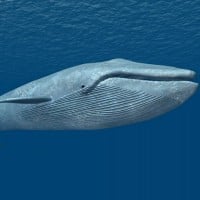 The blue whale (Balaenoptera musculus) is a marine mammal and a baleen whale. Reaching a maximum confirmed length of 29.9 meters (98 ft) and weighing up to 199 metric tons (196 long tons; 219 short tons), it is the largest animal known to have ever existed. The blue whale's long and slender body can... read more
The blue whale (Balaenoptera musculus) is a marine mammal and a baleen whale. Reaching a maximum confirmed length of 29.9 meters (98 ft) and weighing up to 199 metric tons (196 long tons; 219 short tons), it is the largest animal known to have ever existed. The blue whale's long and slender body can... read more The Blue Whale reaches to about 30 meters and weighs about a 100 tonnes. Despite its massive size, its favourite diet was mostly composed of krill and shrimp. The Blue Whale is also known to be one of the loudest animals, reaching up to about 188 decibels.
I know that this is #2, but the fact that it is any lower than #1 is strange. Largest aquatic animal? It's also the largest animal EVER DISCOVERED. How could anything be higher than it.
Not only are they the largest marine animal, but they're the LARGEST ANIMAL TO EVER EXIST.
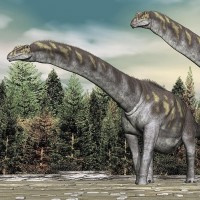 Argentinosaurus is a genus of titanosaur sauropod dinosaur first discovered by Guillermo Heredia in Argentina. The generic name refers to the country in which it was discovered.
Argentinosaurus is a genus of titanosaur sauropod dinosaur first discovered by Guillermo Heredia in Argentina. The generic name refers to the country in which it was discovered. A titanosaurian sauropod from the Cretaceous Period, Argentinosaurus could reach lengths of up to 35-39 meters and weights over a 100 tonnes. Argentinosaurus may have spent much of its day eating due to its ridiculous build and size and there are evidence to support that it indirectly killed much animals. This can be because their feet exhibit such force that when pressed against mud, it left behind a quicksand, arguably about the same size as a large sauropod's feet.
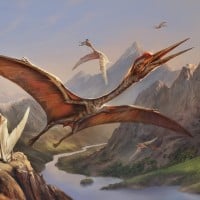 Quetzalcoatlus is a pterosaur known from the Late Cretaceous period of North America (Maastrichtian stage), it was one of the largest known flying animals of all time.
Quetzalcoatlus is a pterosaur known from the Late Cretaceous period of North America (Maastrichtian stage), it was one of the largest known flying animals of all time. An azhdarchidae pterosaur during the Late Cretaceous, Quetzalcoatlus is estimated to have a wingspan of about 10-11 meters, and reaching 5 meters in length. Unlike most other pterosaurs which normally scooped food from watery surfaces like lakes and seas, Quetzalcoatlus was a preferred land scavenger, feasting on dinosaur corpses whenever it got its chance. It could be possible that the giant pterosaur hunted and fed on infant dinosaurs, rodents and fish as well.
P.S. I was going to consider Arambourgiania, but however, claims of it being a 11-13 meter long pterosaur, contemporary research states that it is more leaning to about 7 meters in wingspan.
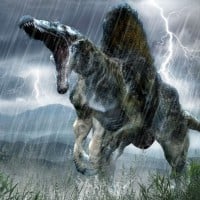 Spinosaurus is a genus of theropod dinosaur that lived in what now is North Africa, during the lower Albian to lower Cenomanian stages of the Cretaceous period, about 112 to 97 million years ago.
Spinosaurus is a genus of theropod dinosaur that lived in what now is North Africa, during the lower Albian to lower Cenomanian stages of the Cretaceous period, about 112 to 97 million years ago. Spinosaurus was the last and largest of the Spinosaurus family class. It was able to reach lengths of up to 16-18 meters, but despite its large and fearsome appearance, its preferred diet happened to be fish. Spinosaurus also lived in the same time and space as another large predator, the Charcharadontosaurus, but we're able to coexist without trouble to to having different dieting preferences.
 The megalodon is an extinct species of shark which was about 59 feet (18 meters) long and hunted in the seas until about 1.5 million years ago. It was similar to today's great white shark-but three times longer and 20 times heavier.
Megalodon had more than 250 huge, razor-sharp teeth and its mouth was so huge that it could easily swallow a person. The fossils of its teeth were once thought to be the tongues of dragons or similar beasts.
Megalodon was in the same shark group as today's great white shark, mako shark, and porbeagle shark. All of these species of sharks are big, fast, fierce hunters-just like their prehistoric relative.
The megalodon is an extinct species of shark which was about 59 feet (18 meters) long and hunted in the seas until about 1.5 million years ago. It was similar to today's great white shark-but three times longer and 20 times heavier.
Megalodon had more than 250 huge, razor-sharp teeth and its mouth was so huge that it could easily swallow a person. The fossils of its teeth were once thought to be the tongues of dragons or similar beasts.
Megalodon was in the same shark group as today's great white shark, mako shark, and porbeagle shark. All of these species of sharks are big, fast, fierce hunters-just like their prehistoric relative. A legendary animal with a notorious reputation in cultural media, the Megalodon reaches lengths of about 18 meters, with its mouth being 2.7-by-3.4 meter mouth and its teeth estimating at least 7.1 inches. The Megalodon ha since gone one to become a popular figure for extinct animals, usually appearing in films as an antagonistic monster. Interesting, there are rumors that the Megalodon still exists. Although unlikely, it is possible, considering about 95% of the oceans are still unexplored...
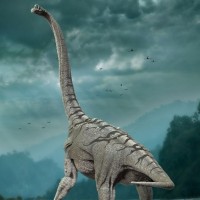
A sauropod in Early Cretaceous North America, Sauroposeidon reached lengths of about 34 meters, making it one of the largest known dinosaurs. Its biggest record however is its towering build, with the animal's head being 18 meters above the ground. It was also the last known sauropod discovered in North America, until the arrival of the Alamosaurus 40 million years later.
An extinct species of bird found in Madagascar, the Elephant Bird reached three meters in height and weighed about 500 kilograms. Another notable feature are the eggs laid by Elephant Birds, which are said to be around 34 centimeters in length, making them largest known bird eggs discovered. Although the reason of its extinction is disputed, human activity is most suspected.
The Haast's Eagle from Australia had a wingspan of about 2.6 to 3 meters in length. However, their bulk was large for an eagles, with females reported to be bigger than males. Female reached about 10-15 kilograms and males reaching 9-12 kilograms. The Haast's Eagle's main diet consisted of a large flightless bird called the Moa. The extinction of the Haast's Eagle can be linked to the Moa's: Humans would hunt the Moa for food, which would ultimately deplete the Haast's Eage from its main food source.
The Paraceratherium was a species of hornless rhino, native to Eurasia. The mammal is estimated to be weigh 15-20 tonnes and reaches a length of 7.4 meters and a height of 4.8 meters. The Paraceratherium's traits included a proboscis, its undeniably massive size that dwarfs most animals and could be hunted by few and its low reproductive rate, the latter which could have been a contributing factor to its extinction.
Cotylorhynchus is a species of synapsid dating back to the Early Permian Period. It was one of the largest synapsids and animals of the Permian Period, reaching lengths of 3 meters. Although they are normally seen to be terrestrial, they have have been aquatic at times.
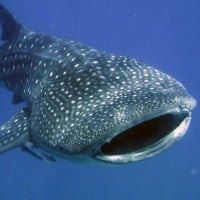 The whale shark is the world's largest living shark as well as the largest living fish. Whale sharks grow up to 45 ft. (13.7 m) long, and can weigh as much as 13 tons (11.6 tonnes). Their mouths alone are a whopping 6 ft. (1.8 m) across-big enough to gulp down three percent of their body weight in food in one sitting. As well as eating planktonic (microscopic) prey, whale sharks will also take nektonic (larger free-swimming) species, including fish and squid, when they get the chance. However, unlike their smaller cousins, these sharks are real gentle. ...read more.
The whale shark is the world's largest living shark as well as the largest living fish. Whale sharks grow up to 45 ft. (13.7 m) long, and can weigh as much as 13 tons (11.6 tonnes). Their mouths alone are a whopping 6 ft. (1.8 m) across-big enough to gulp down three percent of their body weight in food in one sitting. As well as eating planktonic (microscopic) prey, whale sharks will also take nektonic (larger free-swimming) species, including fish and squid, when they get the chance. However, unlike their smaller cousins, these sharks are real gentle. ...read more. While it can't beat the size of the long-extinct megalodon, the whale shark is arguably the largest known extant fish species. According to Wikipedia, the largest confirmed individual had a length of 12.65 m (41.5 ft) and a weight of about 21.5 t (47,000 lb). As a sole member of the genus Rhincodon, the whale shark has several records of its sheer size in the animal kingdom, including being the largest living non-mammalian vertebrate.
I love whale sharks

 The capybara is the largest rodent in the world. It is a member of the genus Hydrochoerus, of which the only other extant member is the lesser capybara.
The capybara is the largest rodent in the world. It is a member of the genus Hydrochoerus, of which the only other extant member is the lesser capybara.